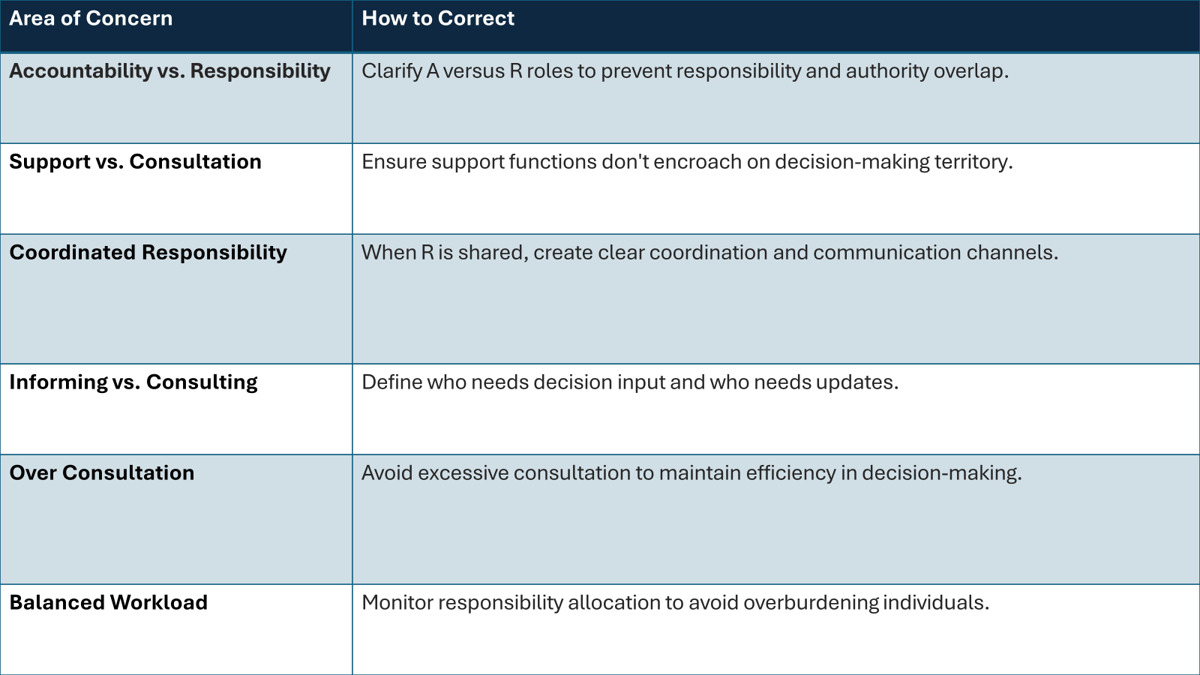As a project manager, one of the most empowering tasks you'll undertake is defining the roles and responsibilities of your team members. This assignment of accountability is not just a critical step in the project chartering process but also a way to show your team members that their contributions are valued and integral to the project's success. When roles and responsibilities are clearly defined, team members can perform their assigned tasks efficiently, leading to faster production and deployment.
If you are a project manager who could benefit from extra support from a PMO expert, check out my offering at the end of this article.

This is not just about you as a project manager but about bringing your project leads together to participate in a collaborative discussion about roles and responsibilities. Meeting in real time is an excellent opportunity for a collaborative discussion to clarify expectations and ensure everyone is on the same page. Schedule the meeting so all participants can be in the same room. If that is not feasible, encourage using cameras in your virtual meeting. Watching body language will provide cues if the roles and responsibility discussion is resonating or if certain parties need the opportunity to express concerns.
It is important to note that achieving alignment among the project leadership team may take more than one session. However, investing time in this alignment process, in the beginning, will save time later on when making decisions during project execution.
One helpful (and often neglected) tool for project management is the RACI (Responsible, Accountable, Consulted, Informed) matrix. A RACI matrix is a chart that helps to identify every task, milestone, or critical decision involved in completing a project. It assigns clear responsibilities for each action item by designating which roles are Responsible, which personnel are Accountable, and, where necessary, who needs to be Consulted or Informed. Using a RACI matrix can help ensure that everyone involved in the project understands their role and responsibilities, helping to keep the project on track.

It's important to consider potential bottlenecks or overlapping responsibilities during any exercise. This will help make the process smoother and more efficient. It's best practice to assign accountability to one person who is ultimately liable for ensuring that the work is completed with high quality. If the saying "One throat to choke" seems too extreme, think of it as "One hand to shake."
The best practice described above is commonly known as the "single point of accountability." Widely recognized and effective, this approach ensures clarity and accountability. The idea is that for any given task or deliverable within a project, there should be one person who is ultimately accountable. This person has the authority to make final decisions and is answerable for the success or failure of the task.
However, it's important to differentiate between being accountable and being responsible. While only one person should be accountable (A) for a task, multiple people can be responsible (R) for carrying out the work related to that task. The accountable person may delegate various responsibilities, but they retain overall accountability.Here are a few other pointers on clarifying each R-A-C-I:

Once roles and responsibilities have been defined, it's not just about the project manager but everyone committing to their assigned tasks. This means holding team members accountable for their assigned tasks and ensuring everyone works together towards the common goal. This sense of accountability and responsibility is not just crucial, but it's what makes the project successful. There are several ways to make these agreements actionable in your project. Here are a few suggestions.
Defining roles and responsibilities is a continuous process that needs to be revisited as the project progresses and the team members change. The project manager ensures that the RACI matrix is referred to, reviewed, and updated throughout the project's lifecycle. The other workstream leads should also maintain the roles and responsibilities to ensure the project’s success.
As part of the project, planning for a smooth handover is crucial once the project is completed. To begin with, the project team should utilize the RACI matrix to identify the tasks and processes that will require ongoing attention after the project goes live. Since project team members may move on to other projects, it's essential to hand over the task to a resource on the production support team. The RACI matrix will help to determine which roles and responsibilities need to be transitioned and which parties require knowledge transfer.
Defining roles and responsibilities is crucial to ensure project success. Use the RACI matrix to assign clear responsibilities for each task. Identify bottlenecks and assign accountability for high-quality work. Continuously review and update the roles and responsibilities throughout the project. Plan for a smooth handover by creating a RACI matrix for ongoing governance. By following these best practices, project managers can ensure their projects are successful and achieve desired outcomes.
If you are a project manager or other project lead and need help defining the roles and responsibilities of your team members, I recommend checking out my offering: "Kickstart Your Project with Precision: Roles and Responsibilities Workshop with Kimberly Bortz" on MentorCruise. This step-by-step, one-on-one coaching journey will provide you with the necessary skills and techniques to define the backbone of your project's success through a structured approach to roles and responsibilities.
Find out if MentorCruise is a good fit for you – fast, free, and no pressure.
Tell us about your goals
See how mentorship compares to other options
Preview your first month
